How To Remove Seamless Gutters
How to Install and Supervene upon Gutters
Larn how to install potent, sleek-looking gutters.
![]() Time
Time
Multiple Days
![]() Complexity
Complexity
Intermediate
![]() Toll
Toll
Varies
Introduction
Create stronger, better-looking gutters past modifying standard gutter systems. Minimize joints; assemble stiff, sleek-looking seams; and add roof flashing to go on water flowing into the gutters where information technology belongs.
Tools Required
Materials Required
- ane 1/four" cocky-tapping hex caput screws
- 1/4" hex head screws ('zippers')
- one/viii-in. medium length rivets
- Downspouts
- Elbows
- Gutter
- Gutter flashing
- Gutter hanging strap
- Gutter sealant
Planning the Rain Gutter Replacement Project
Almost all home centers and full-service hardware stores sell guttering designed for easy installation. Simply with just a little more piece of work, you tin can use these same parts to put together pelting gutters and downspouts that are stronger and better looking also.
Evaluate and Programme the Gutter Replacement Project
DIY gutter replacement can save yous essentially over professionally installed gutters, but there are a few pitfalls to watch out for. Inspect the fascia and soffit (Fig. B, below) for signs of rotted wood, which must be replaced before you put up the rain gutters. Many houses accept a trim board or crown molding nailed to the fascia just under the shingles. Yous'll need to remove this, as we did, or add a continuous strip of woods under information technology to create a flat plane for the gutters. In either example, prime and paint bare wood earlier you lot hang the gutters.
Draw a Sketch and Measure Your House Before Installing Rain Gutters
Fig. A (beneath) shows an example of a rain gutter organization for a typical house. Record the length of the rain gutter runs and marker the downspout locations. Then count up the within and outside corners and end caps (note whether they are correct or left ends). Mensurate the peak of downspouts and add together 4 feet to each for the extension away from the house at the bottom.
Each downspout requires three elbows. There are two types of elbows that turn either to the forepart or side of the downspout. Most installations require only front elbows, but occasionally you may need a side elbow, commonly to plough the downspout extension sideways. Here are a few planning tips:
- Locate downspouts in unobstructed areas where water can be directed away from the firm. Avoid locations with obstacles like electric meters, hose bibs or sidewalks.
- Place downspouts in inconspicuous locations if possible.
- Install oversized 3×4-in. downspouts on gutters that drain big roof areas or if you live in an area with torrential rains.
- Gradient long gutter runs (xl anxiety or more) down both directions from the middle and put a downspout on each end.
- Buy special roof hanger mounting straps for houses without fascia boards or for fascias that aren't vertical.
Gutter Parts and Mounting Details
Measure the horizontal rain gutter runs and downspouts and identify the parts you'll need.

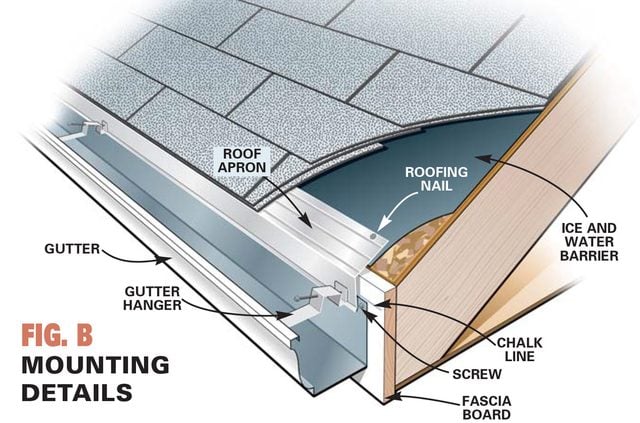
Projection step-by-pace (20)
Stride 1
Cut the Gutter
- Information technology'southward much easier to join sections on the ground than to work from the acme of a ladder.
- Instead of butting parts together and covering the joints with a seam encompass as recommended by the manufacturer, lap all seams from two to four inches.
- Cut the front and back sides with tin snips.
- Bend the gutter and cut the bottom.
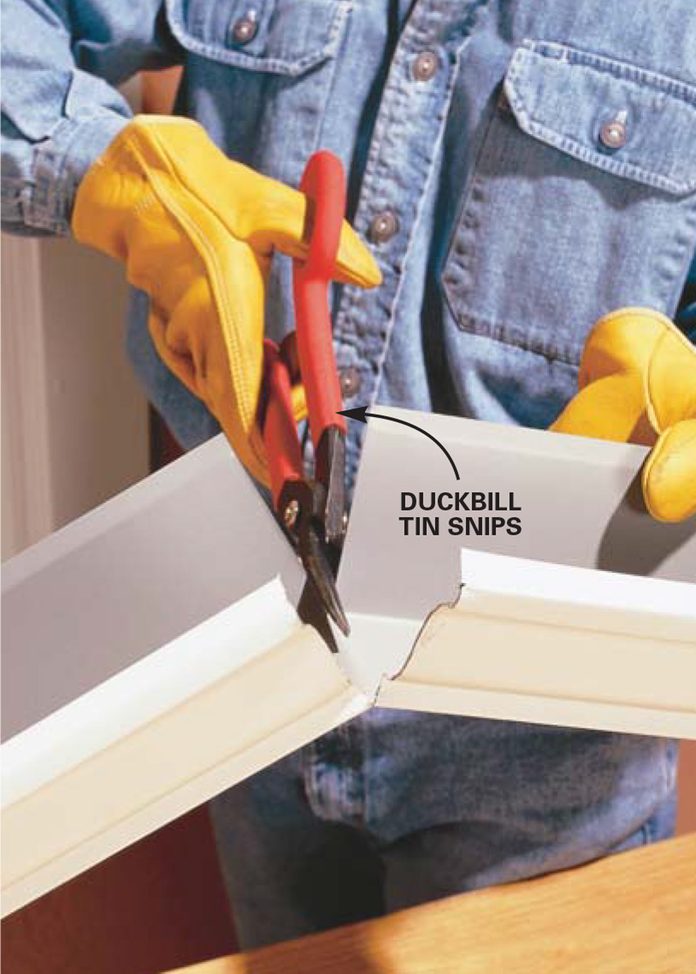
Step two
Notch the Gutter
- Cut a two inch long notch in the front lip of the gutter with can snips to bring together a rain gutter section with an inside or outside corner piece.
- Pro tip: Cut a four inch long notch to overlap and splice together gutter sections.
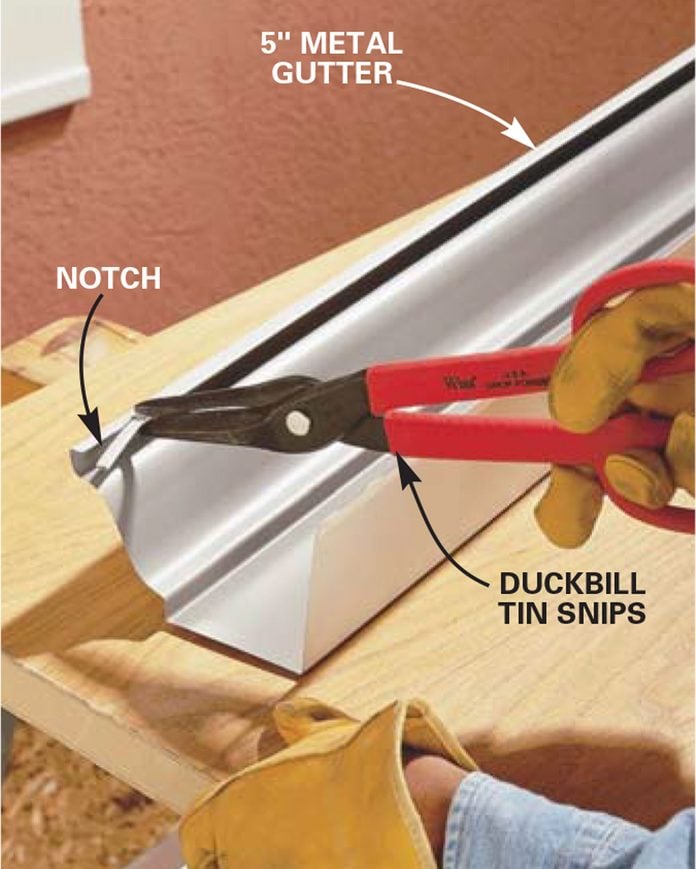
Step 3
Snap the Sections Together
- Lay a bead of gutter sealant along the corner 1-1/2-in. back from the edge.
- Hook the front lip of the corner over the notched section of gutter and snap information technology over the gutter.
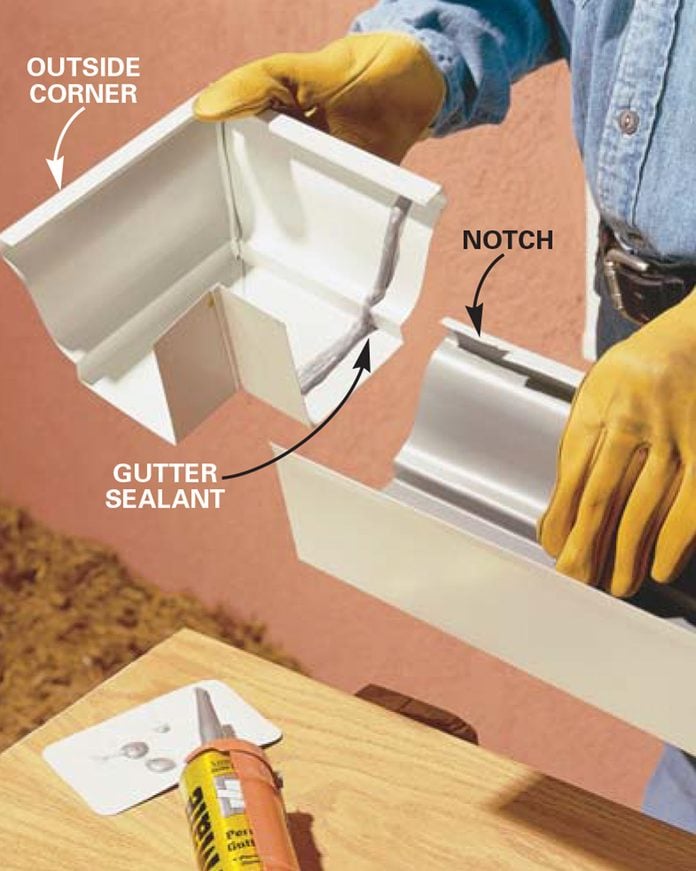
Step 4
Rivet the Sections
- Join the gutter to the corner with half dozen rivets in the locations shown.
- Commencement past drilling a 1/8-in. hole (for 1/8-in. rivets) at the front of the gutter and installing the outset rivet with the rivet gun.
- Now drill the remaining holes and install the rivets.
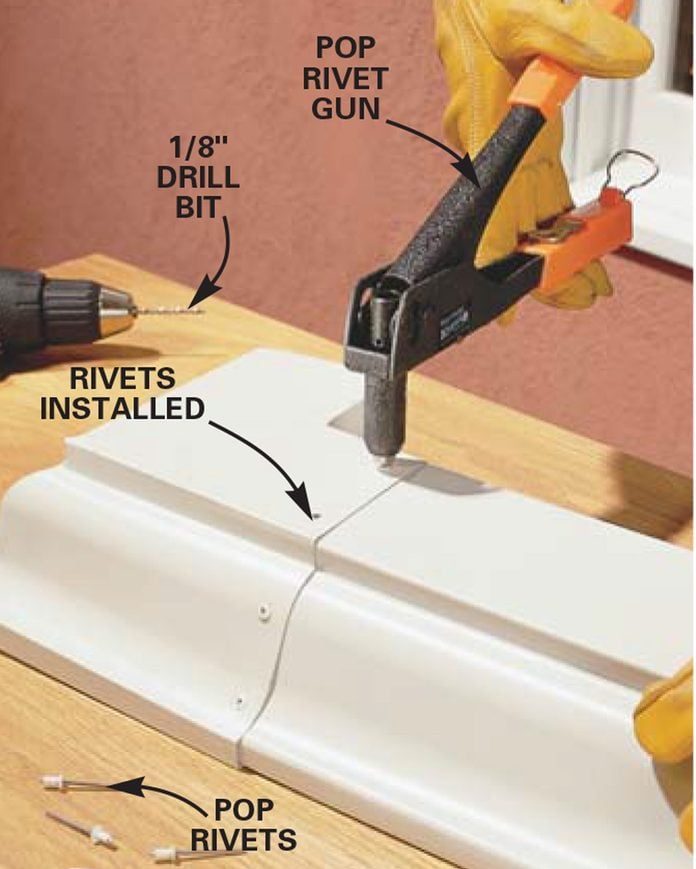
Stride 5
Caulk the Seam
- Caulk the seam on the inside of the rain gutter with gutter sealant.
- Put a dab of sealant over each rivet.
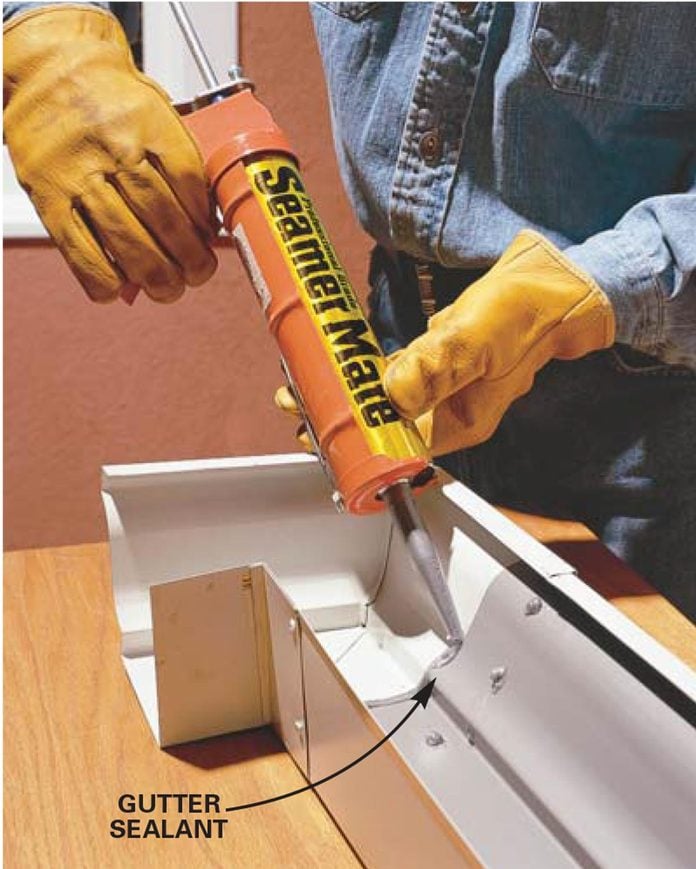
Stride vi
Preassemble Before Installing Gutters
- We've shown joining a gutter section to a corner.
- Use the aforementioned process to join 2 sections of gutter, except overlap the pieces at least four inches.
- When you're splicing gutter sections, plan ahead to go out the all-time-looking factory-cutting finish on the outside if possible.
- Also, lap the pelting gutters and so the inside section is facing downhill to prevent h2o from being forced out the seam.
- Where a gutter ends, cutting it to extend near an inch past the end of the fascia board to catch h2o from the overhanging shingles.
- Then attach an end cap with rivets and seal the joint from the inside with gutter sealant.
Step 7
Marker the Downspout Outlet
- Outset, measure out from the corner of the house to the middle of your called downspout location.
- Double-check for obstructions.
- Transfer this dimension to the gutter and cut in a downspout outlet.
- Pro tip: This method takes a few minutes longer than using one of the short gutter sections with a preinstalled outlet, just it eliminates ii seams and looks much neater.
- Mark the center of the downspout outlet on the bottom of the gutter.
- Middle the outlet, flange side down, over the mark and trace around the inside.
- Cut a 5-shaped notch with an old chisel as a starting hole for the tin snips.
- Identify two curt scraps of 2x4 side by side under the gutter to support it while you chisel the notch.
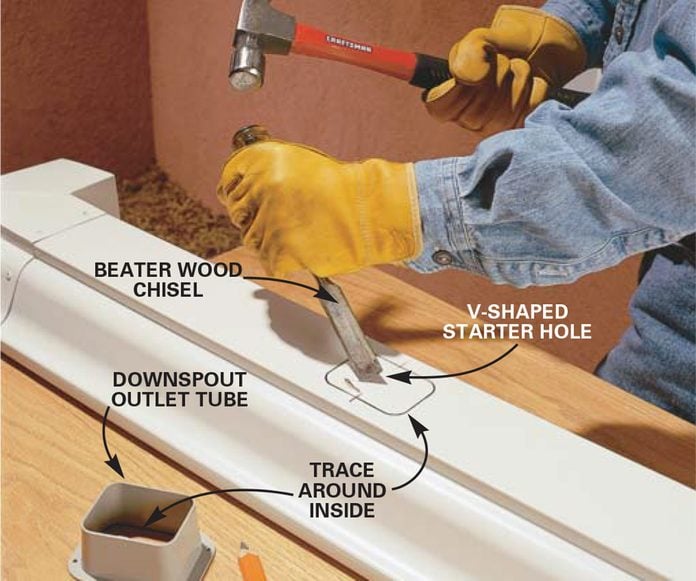
Step viii
Cutting the Outlet Hole
- Cut out the outlet hole with start tin can snips.
- Pro tip: Ruby tin snips cut counterclockwise. Green snips cut clockwise. Either will piece of work.
- Cutting 1/16-in. exterior the line.
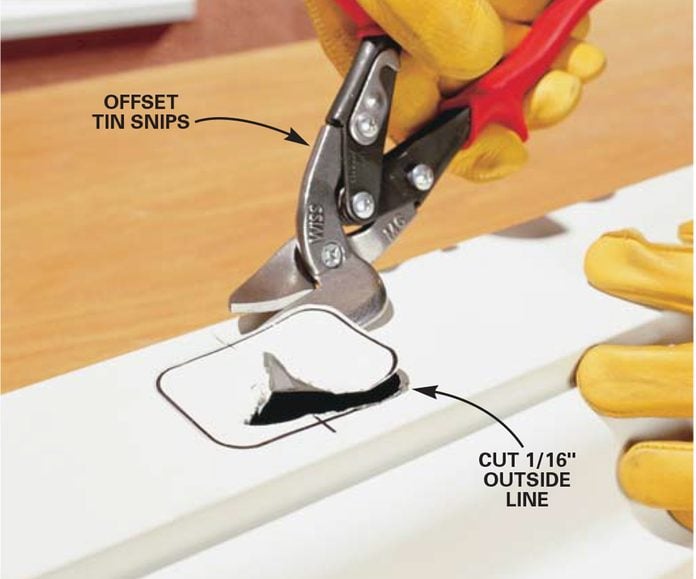
Footstep 9
Rivet the Outlet in the Hole
- Skid the outlet into the hole and predrill 1/eight-in. holes for the rivets.
- Remove the outlet and run a bead of gutter sealant effectually the opening.
- Printing the outlet into the caulked opening and install the rivets.
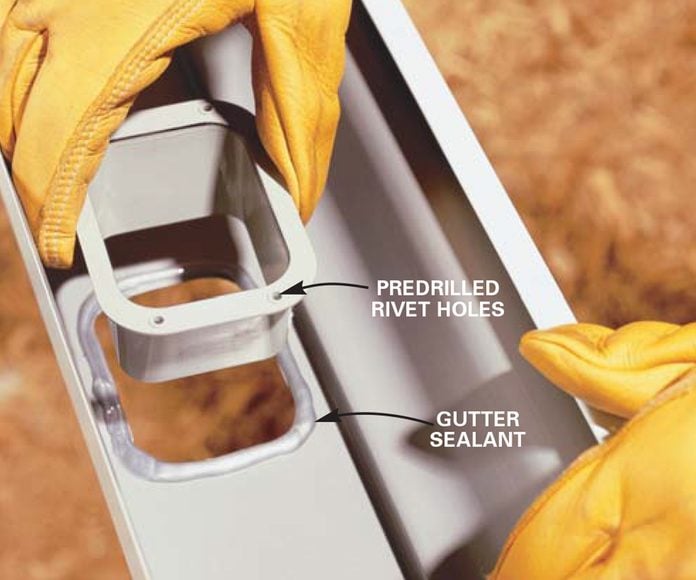
Step 10
A Little Slope is All You Need
- The number and size of downspouts decide how fast your gutters will empty.
- Sloping them helps eliminate standing water that can crusade corrosion and leak through the seams.
- Gradient each house gutter run down toward the downspout about 1/4-in. for every 10 feet of gutter.
- If your fascia boards are level, you can use them as a reference for sloping the gutters.
- Check this by holding a level against the bottom edge.
- If they aren't level, adjust the cord line until a level aligned with information technology shows a slight slope.
- Snap a chalk line to indicate the top of the gutter.
- And so straighten gutter sections as y'all screw them to the fascia past aligning the pinnacle edge with the chalk line.
Step eleven
Marking the Gutter Slope
- When installing gutters, set the proper slope by driving a nail i/2-in. below the shingles on the high side of the gutter run.
- Mensurate and record the distance from the bottom of the fascia board to this blast.
- Decrease 1/4-in. for every 10 anxiety of gutter from this measurement and mark this distance at the low end of the gutter run.
- Drive a smash at this mark and stretch a chalk line betwixt the ii nails.
- Align a level with the string to cheque the gradient. The bubble should be off-center toward the high side.
- Pro tip: If it'southward not, accommodate the cord until the chimera indicates that you have the proper slope.
- Finally, snap the cord to mark a line on the fascia board.
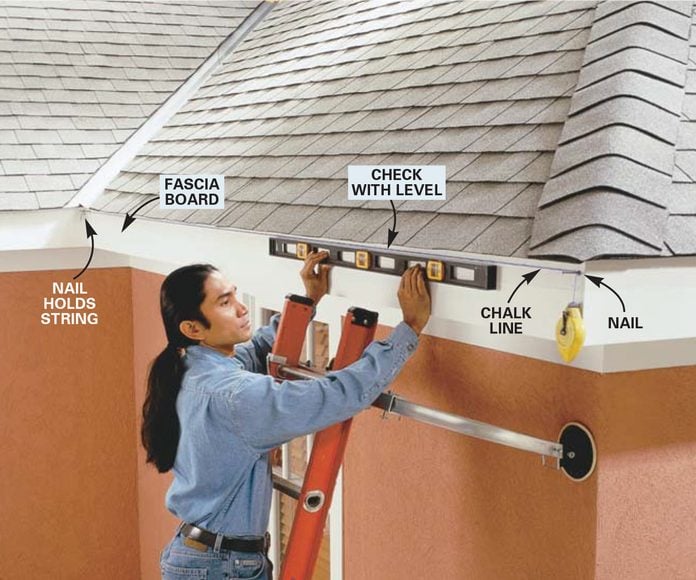
Step 12
Screw the Gutter to the Fascia
- Drive 1-1/iv-in. stainless steel hex caput sheet metal screws through the back of the gutter into the fascia.
- Install one screw every two feet.
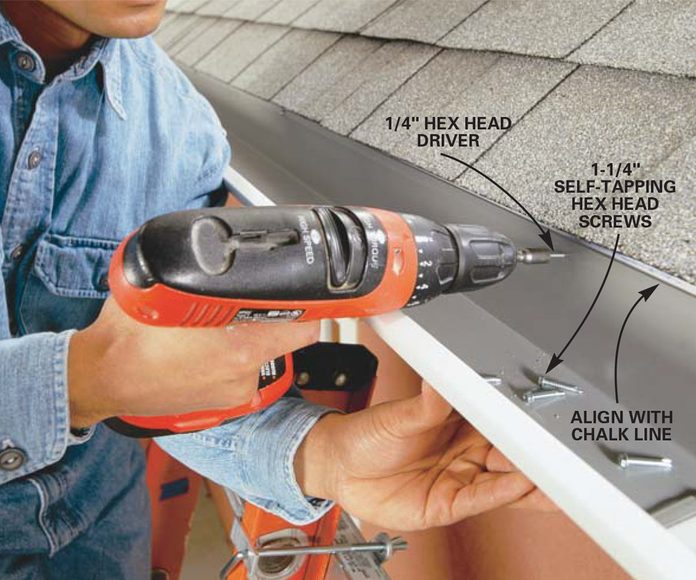
Step 13
Add Gutter Flashing
- With gutter replacement, you can prevent water from running behind your gutters by installing a metallic gutter frock flashing nether the shingles and over the back edge of the gutter.
- If your habitation middle or hardware shop doesn't sell pre-bent flashing, ask an aluminum siding contractor or local sheet metallic fabricator to bend some for you.
- Ideally the flashing should be slid nether the shingles and the roofing paper or water ice and water barrier.
- Pro tip: If this isn't possible because the water ice and h2o barrier is stuck to the sheathing, or there are too many nails and staples forth the edge of the covering paper, then just slip the flashing under the shingles.
- Pro tip: If the flashing yous're using is too short to attain down over the back border of the gutter, slip an additional strip of sheet metallic flashing under the bent flashing and over the gutters.
- Slide gutter flashing under the shingles and secure with one-inch covering nails every two feet.
- Lap sections virtually 2 inches.
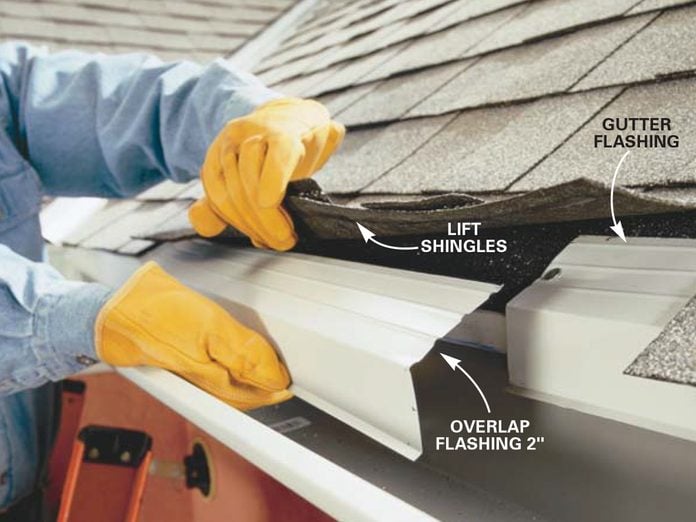
Step 14
Hook on Gutter Hanging Straps
- With the gutters screwed to the fascia, it's a unproblematic job to install the hidden gutter hangers.
- Install hangers every two anxiety to support the gutters and strengthen the front edge.
- The hangers are designed to skid over the back edge of the gutter. But since nosotros've covered this edge with flashing, but hold them level and drive the screws through the flashing and gutter back into the fascia.
- Pro tip: The gutter apron will prevent you lot from slipping the hangers over the back edge of the gutter as intended.
- The big screws included with the hangers we used are a little catchy to get started, especially through steel gutters and flashing.
- Spin them at loftier speed without applying much pressure until the screw tip bites into the metallic.
- Then lean on the drill and drive them into the fascia.
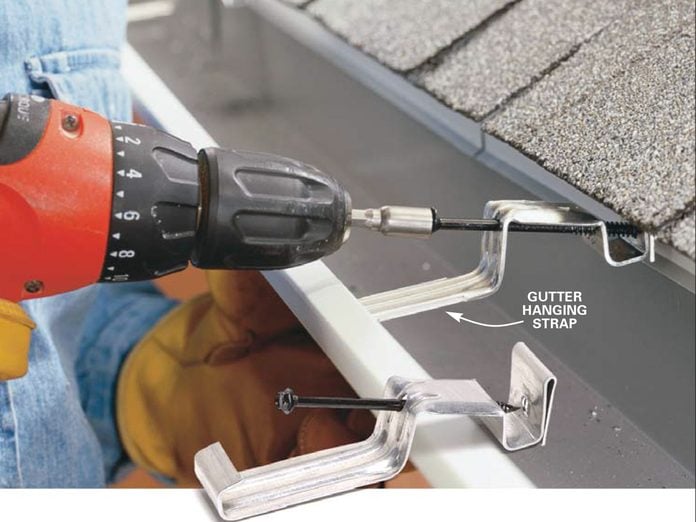
Footstep fifteen
Attach Elbows to the Downspout
- We're using standard 2x3-in. downspouts, but the procedure for oversized 3x4-in. ones is the same.
- Get together the elbows and downspout tube with the crimped ends facing downward to prevent water from leaking out of the joints.
- Utilise sheet metal screws rather than rivets so you tin disassemble the downspouts to make clean them if necessary.
- Pro tip: Pros prefer pre painted i/4-in. hex head screws with sharp points, chosen "zippers" because they're piece of cake to install. We found these screws in the aluminum siding section of a habitation center, but a gutter supplier would be another good source.
- Spiral an elbow to the downspout outlet.
- Concord another elbow against the wall and measure betwixt them.
- Allow for a 1-1/2-in. overlap at each end.
- Use a hacksaw to cutting this length from the uncrimped end of a downspout tube.
- You tin can cut downspout tubing with a 32-tooth hacksaw blade, only the pro nosotros talked to uses a circular saw with a standard 24-molar carbide blade.
- Pro tip: A power miter box also works not bad for cutting gutters and downspouts. Use an former blade, though. Protect yourself from flying $.25 of metallic with goggles, leather gloves, jeans and a long-sleeve shirt.
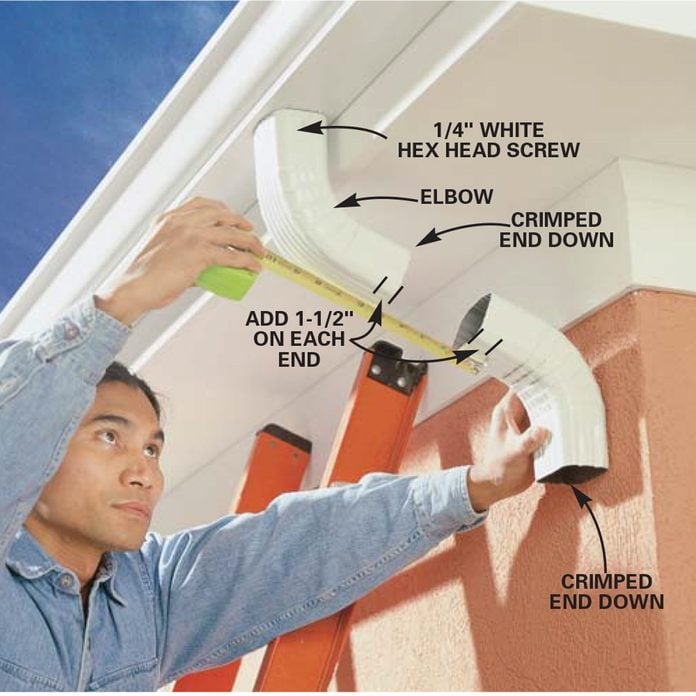
Step 16
Crimp One End of the Downspout
- Crimp one terminate of the curt length of downspout with a special sheet metal curling.
- With the three blades on the inside of the tube, hold the crimper against the inside corner of the tube and squeeze.
- Crimp three times across both long edges and twice on the narrow sides.
- Attach this curt section of downspout to the two elbows with ii one/4-in. hex head sail metal screws into each joint.
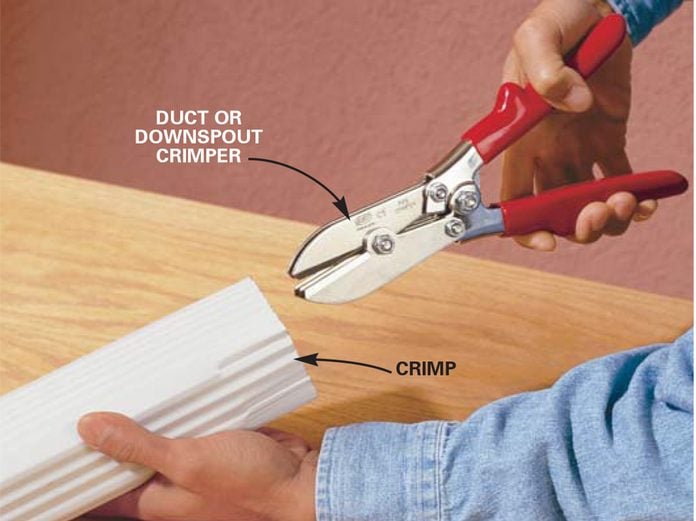
Step 17
Fasten Brackets to the Wall
- Each length of gutter and every elbow is squeezed, or crimped, on one end to let the pieces to fit together, one inside the other.
- Since 10-ft. lengths of downspout are only crimped on one end, you lot'll accept to crimp one cease of any cutoff piece to brand it fit inside the next elbow or downspout section.
- Pro tip: If you only have ane or 2 downspouts to install, you tin can use a needle-olfactory organ pliers to twist crimps into the finish. But an cheap crimping tool will save you tons of time and frustration.
- Crimp one stop of the brusk length of downspout with a special sheet metal crimper.
- With the three blades on the inside of the tube, concord the crimper against the inside corner of the tube and squeeze.
- Crimp three times across both long edges and twice on the narrow sides.
- Attach this brusk section of downspout to the two elbows with ii 1/4-in. hex caput canvass metal screws into each joint.
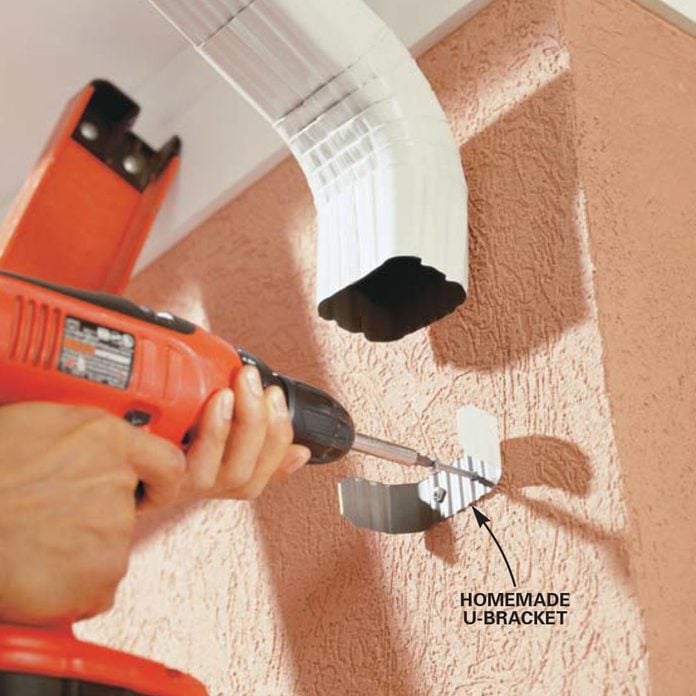
Step 18
Attach the Downspout to the Brackets
- Finish the gutter job by attaching the downspouts to the wall.
- Pro tip: If y'all can't find U-shaped brackets, brand them from sections of downspout. They look improve than the bands that wrap around the outside and make it easier to hang the downspouts.
- Drive screws through the brackets into the assembled downspout.
- Complete the assembly past adding a length of downspout tube to the lesser elbow to direct water abroad from the foundation.
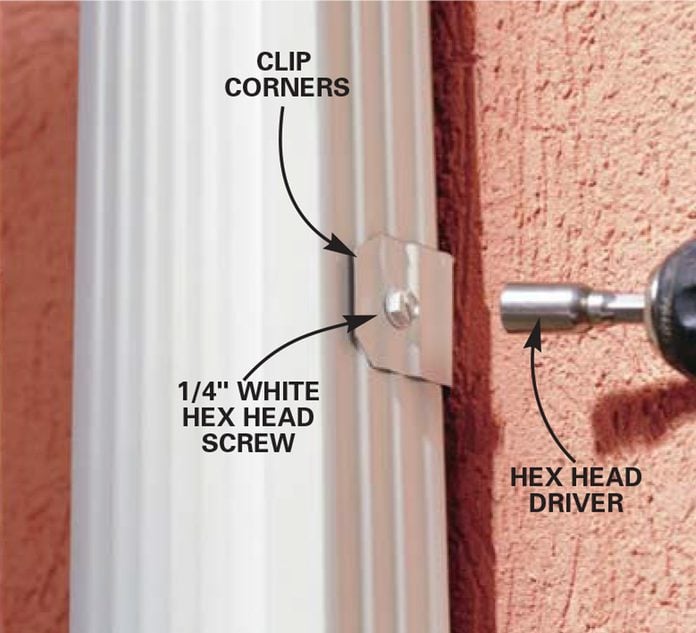
Step 19
After Installing Gutters, Maintenance Is the Fundamental to Long-Lasting Gutters
- Clean leaves from your gutters twice a twelvemonth, or hire a visitor that specializes in gutter cleaning and maintenance.
- You'll extend the life of your gutters and eliminate problems like backed-up gutters and plugged downspouts.
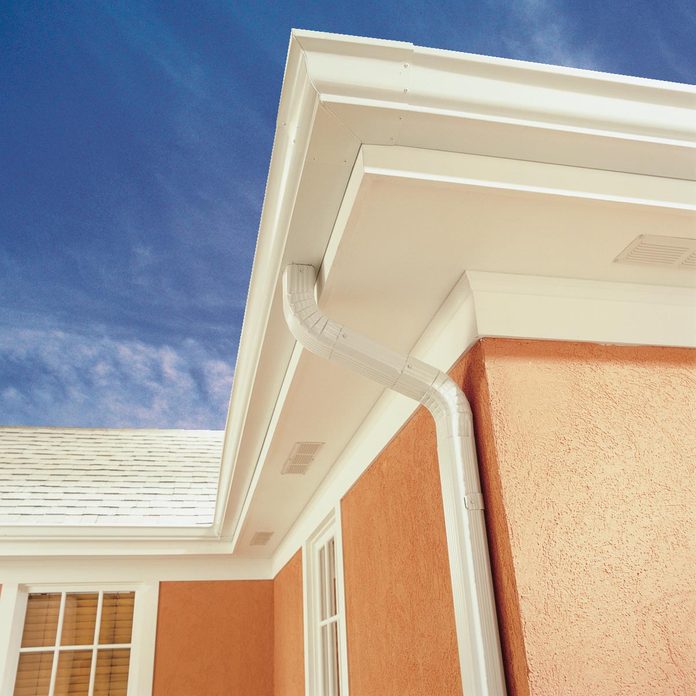
Step 20
Buying Gutters
- 10-foot lengths of metal gutters, downspouts and accessories are bachelor at home centers, lumberyards and total-service hardware stores.
- Standard colors are brownish and white.
- Matching inside and exterior corners, downspout elbows and accessories are besides bachelor.
- Buy special gutter sealant to seal the seams.
- It's available in small toothpaste-type tubes or x-oz. caulk gun tubes.
- Using many of the same bones techniques we show in this story, y'all tin can install your own "seamless" gutters.
- Many seamless gutter companies will come to your house, measure out and class continuous lengths of aluminum gutter to fit, and sell you all the installation accessories you'll need.
- It costs a little more, but y'all'll be able to choose from dozens of colors and eliminate seams in the gutter runs.
- You'll besides save the hassle of measuring, shopping and hauling the parts dwelling house in your VW bug.
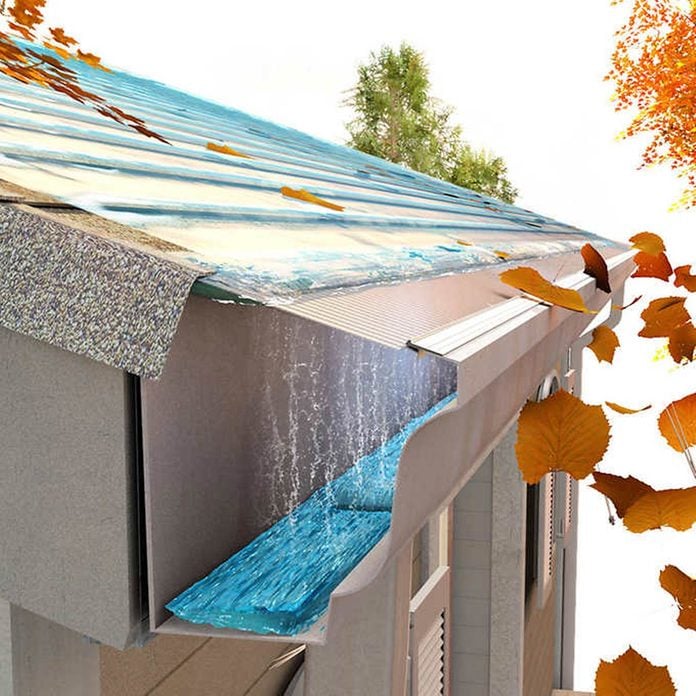
Originally Published: July 27, 2022
Source: https://www.familyhandyman.com/project/how-to-install-gutters/

0 Response to "How To Remove Seamless Gutters"
Post a Comment